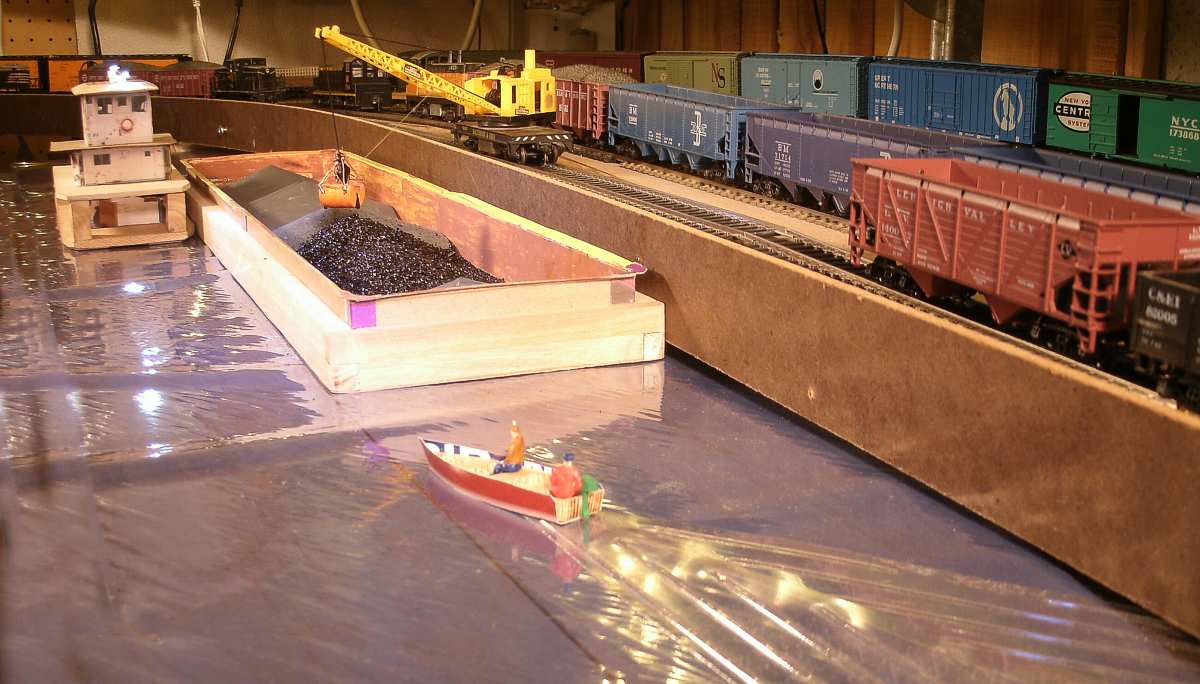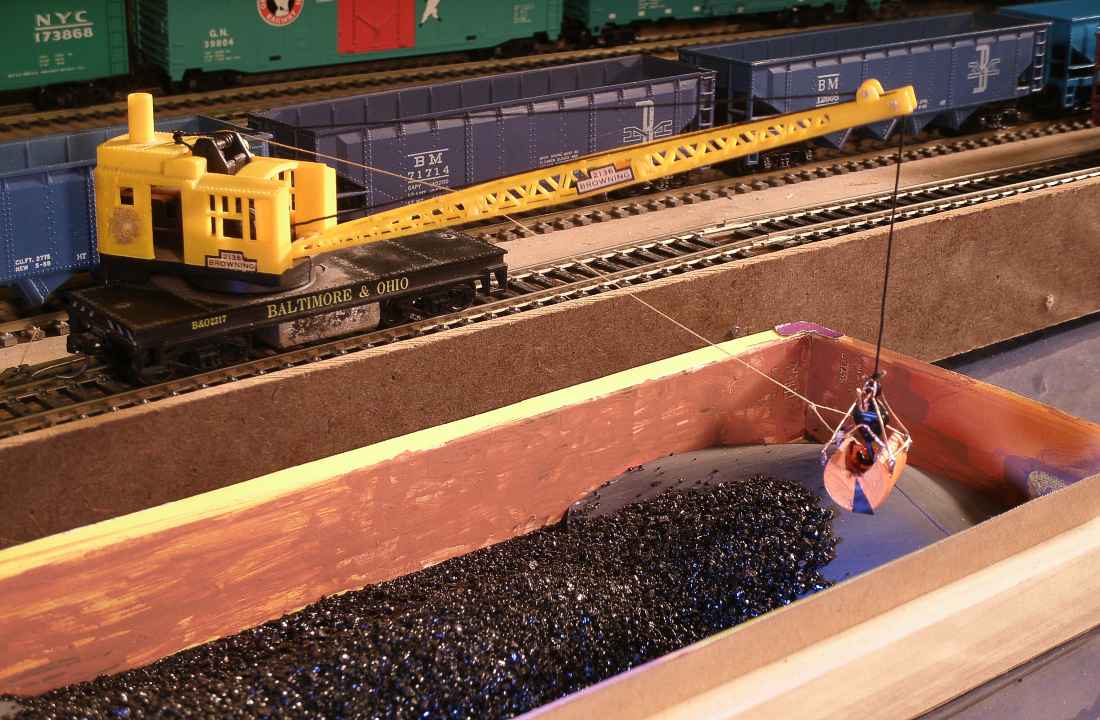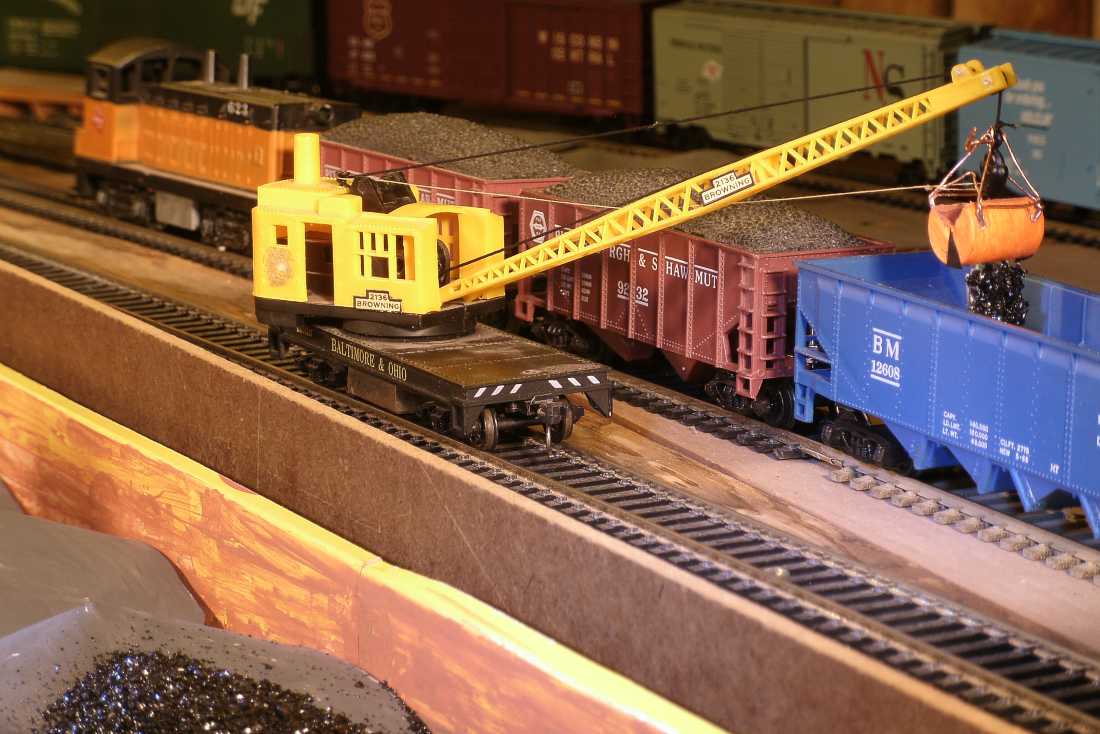|
After many years, I finally made a simple simulation of a river barge unloading dock for my model railroad.
My operating theme of the railroad is the Milwaukee Road tracks from Wisconsin to Iowa. I don't think the real railroad hauled coal like I do; I haul from a river terminal to a cement processing plant in Iowa / Minnesota that is about 40 miles away. I stretch and shrink the real geography to suit my operating mood and how many laps I want to run around the room. Some trains don't terminate for 3 weeks; if I have a colorful consist I may just keep running it.
I have been watching some real towboat traffic on the Keokuk Lock Visitor Center Livestream webcam,
So, my model rail scheme will have to switch from getting coal barges of high quality Kentucky coal to getting coal by the train load from the underground mines of central Illinois (near Polo, a RR track that was abandoned in the 1990's, a decade later than my operating theme).
|

| The reflecting water of the Mississippi River is the same board with a plastic covering that I use to simulate the Mississippi River near the floating pontoon bridge that is 2 miles (10 real feet) away from here. This is a handy storage spot in the 'back room', but it makes for a smaller aisle. |
|
The rail crane is a Life Like model from the 1970's that I bought at a Woolworths (or McCrory's or similar) store in Rhinelander, Wisconsin. Back in those days, those early discount stores sold some interesting toys.
I could guess it's a 25-ton Browning crane.
My web search brought up www clevelandmemory org which has pictures of the Browning Engineering Co. of Cleveland, Ohio.
This railcrane is handy for this location. I improved my original track plan so it has two tracks side by side. The rail crane can move itselt alongside the barges to reach the coal piles.
|

.
|
The coal is from a little box of Life Like coal that I've had for 30 years. The outside of the box is almost brown from dust bunnies, but the coal inside the bag is still shiny black. The 'duller' piles of coal in the barge are just paper cones, painted dull gray / black. . Swing the 'house' and dump the bucket into the empty coal hopper car. |

|
The plastic model has a lifting hook, but I pinned a homemade clam bucket to that. I didn't paint the copper wire yoke yet. (i haven't painted a lot of stuff yet, such as the outside of the barge, it's still wood and not brown steel.) |
|
How many buckets per hour can a rail crane transfer from barge to rail car? Coal is 42 to 57 lbs per cubic foot, compare that to stone at 160. I shoveled a small pile of coal once, and found it 'surprisingly light'.
2-yard bucket, 2 x 27 cubic feet per yard = 54 cu ft
That's my estimate for a cable-operated machine. I expect to haul a train load twice a week, so maybe I should get a second crane to keep up with demand.
|
|
So, how much coal do I need to move? It goes to a cement manufacturing plant, where it is burned to make cement clinker from limestone. A cement plant can make about 1200 tons a day.
The internet shows that I need to burn about 400 lbs of coal to make one ton of cement (not concrete). 1500 tons per barge = 27 train cars hauling 55 tons each (this an old model railroad from the 1960's and 70's), or 21 cars hauling 70 tons each. I don't know if the coal is weighed along the way, such as at the tipple at the source, or by the car load passing over a railroad scale on the way to it's destination, or if someone just measures the water line to get the displacement of the barge as it's loaded or unloaded. Coal is priced by weight, but also by energy value, in calories or BTU's. That is determined by the seller or buyer by putting a few ounces of coal that's been pounded to dust into an aluminum burst-proof can that is placed in a water tank. The coal is ignited inside the container, and the temperature change of the water bath is recorded and from that, the calories are calculated. |
|
I have some 55-ton Greenville Car Company hoppers at 34 ft long. Some are even just 30 feet long. Old Varney brand. Handy for the cramped quarters of the unloading track at the cement plant, which has a tight 11-inch radius for HO scale. It's crammed inside of a reversing loop. The short cars roll good enough and make a suitable train for the track curves winding around the river valleys. |
This page was wrote in December, 2021